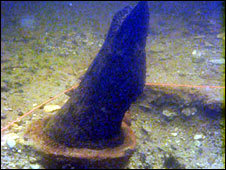
|
| ©Unknown |
| One of the tree stumps could date back to 4,270 BC |
The stumps of about 50 trees were discovered in 2005 - some of them are thought to be about 6,000 years old.
The experts are now aiming to find their root system and establish the depth to which the trees are buried.
Meanwhile, a campaign has been launched to help restore the reconstructed crannog, an ancient loch dwelling, which attracts thousands of visitors.
The Scottish Trust for Underwater Archaeology will spend the next two weeks inspecting the drowned forest.
They will be focusing on two trees - one dating from 4,270 BC to 4,040 BC and the other dating from 2,350 BC to 2,120 BC.
As well as looking for the tree roots, they will be taking samples of the sediment and organic materials to establish if there were any landslips taking place between the Mesolithic and the Bronze Ages.
Barrie Andrian, who is an underwater archaeologist, told the BBC Scotland news website they could also uncover other secrets.
She said: "Last year, when we took a sample of organic material - because that's one of the beauties of underwater archaeology, all the things are preserved very well underwater generally - we found a sample that had evidence of charcoal, bone and cereal grains.
The experts are unsure whether it washed in from another crannog, from the shore, or by another means.
'Human impact'
She added: "Potentially we could be finding evidence of human impact on the environment from several thousand years ago.
"But in general terms, in underwater archaeology we're looking for remains of people travelling up and down the loch, things they've dropped, how they've used the loch and settlement alongside or in the water, because crannogs were built out in the water.
"So if we're going to find out more information about crannogs and the people who built them and lived in them we need to excavate underwater."
Ms Andrian is also the director of the Scottish Crannog Centre, near Aberfeldy, which is visited by an estimated 25,000 people every year.
The centre is urgently in need of money to refurbish the reconstructed Iron Age home on the loch.
Ms Andrian said: "When we started building in 1994, and it was a total experiment, we were using authentic materials, so no pile drivers, no water proofing, no weather proofing, no creosote, no nothing, just the way it would've been done in the past.
"We used the same species as the ancient people did - that's mainly alder, we would've liked to use more oak because there was oak in the original houses as well, but obviously oak is very expensive.
"What we've discovered since then is that alder doesn't last very long in the water - that's because the most exposed parts of the timbers are where the loch level rises and falls between winter and summer and it's causing erosion in that area."
Staff will now look into ways of naturally protecting the structure and Polish specialists have even visited to give their advice.



Reader Comments
to our Newsletter